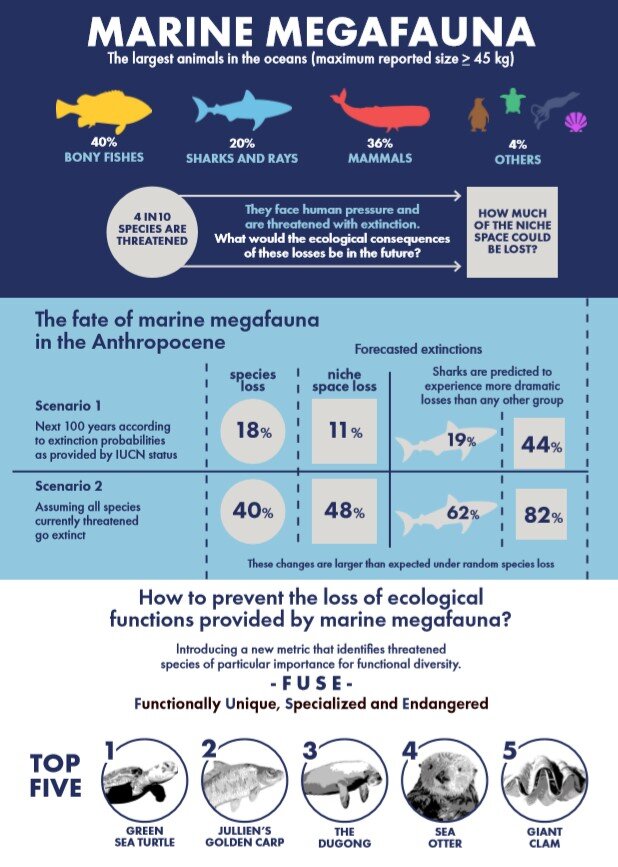Scientists Forecast Dire Consequences for Marine Ecosystems at Current Trends of Extinction, Loss of Sharks Have Greatest Consequence
An international team of researchers examined the roles of marine megafauna species to better understand the potential ecological consequences of their extinction under different future scenarios. Extinction of threatened marine megafauna will lead to a huge loss in functional diversity in marine ecosystems, the researchers concluded.
The team of researchers led by Swansea University’s Dr Catalina Pimiento compiled a species-level trait dataset for all known marina megafauna in order to understand the extent of ecological functions they perform in marine systems, and the associated impacts on ecosystems if current extinction trends continue.
Marine megafauna are defined as the largest animals in the oceans, with a body mass that exceeds 45kg. Examples include sharks, whales, seals and sea turtles. Sea otters are also included due to the significant ecological role as keystone species.
Sharks, dugongs and sea turtles serve critical roles in ecosystems by consuming large amounts of prey biomass, transporting nutrients across habitats, connecting ocean ecosystems via migration, and physically modifying habitats by foraging and disturbance.
Biological features such as body size and weight, types of prey or forage and range of movement determine a species’ ecological functions. Measuring the diversity of these traits allows scientists to quantify the contributions of marine megafauna to ecosystems and assess the potential consequences of their extinction.
The researchers at Swansea University developed a new conservation metric, FUSE (Functionally Unique, Specialised and Endangered) identifies threatened species of particular importance for functional diversity. The highest-scoring FUSE species include the green sea turtle, the dugong and the sea otter. A renewed focus on these, and other highly-scoring FUSE species, will help ensure the maintenance of ecological functions provided by marine megafauna.
“Our previous work showed that marine megafauna had suffered an unusually intense period of extinction as sea levels oscillated several million years ago. Our new work shows that, today, their unique and varied ecological roles are facing an even larger threat from human pressures.”
Dr Catalina Pimiento, lead author, Swansea University
After simulating future extinction scenarios and quantifying the potential impact of species loss on functional diversity, they introduced a new index (FUSE) to inform conservation priorities.
The results showed a diverse range of functional traits held by marine megafauna, as well as how the current extinction crisis might affect their functional diversity.
Sharks are predicted to be the most affected group, with losses of functional richness far beyond those expected under random extinctions.
The authors predict that if current trajectories of extinction are maintained, we could lose, on average, 18% of marine megafauna species, which will translate in the loss of 11% of the extent of ecological functions in the next 100 years. However, if all currently threatened species were to go extinct, we could lose 40% of species and 48% of the extent of ecological functions.
“Our results show that, among the largest animals in the oceans, this so-called “redundancy” is very limited — even when you roll in groups from mammals to molluscs. If we lose species, we lose unique ecological functions. This is a warning that we need to act now to reduce growing human pressures on marine megafauna, including climate change, while nurturing population recoveries.”
Dr John Griffin, Swansea University
It is critical to protect threatened and endangered marine megafauna, especially sharks, or the cascade effects will have dire consequences for food security, bio dversity and ecosystem health.
Protecting sharks might just be the solution to saving biodiversity and ecosystem functions.

Journal Reference:
- C. Pimiento, F. Leprieur, D. Silvestro, J. S. Lefcheck, C. Albouy, D. B. Rasher, M. Davis, J.-C. Svenning, J. N. Griffin. Functional diversity of marine megafauna in the Anthropocene. Science Advances, 2020; 6 (16): eaay7650 DOI: 10.1126/sciadv.aay7650